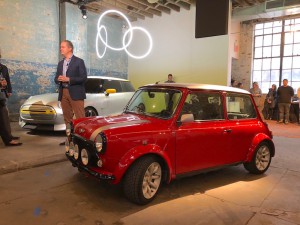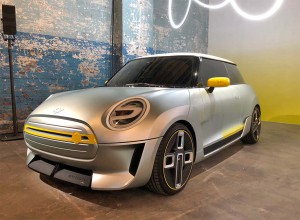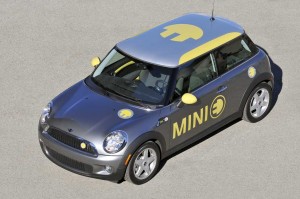
Look beyond the retro Mini Electric Concept and you'll see what the British marque's first all-electric car really will look like come late 2019.
It took a little prodding and plenty of cajoling, but we’re now able to fill in some more of the blanks when it comes to the all-electric model that Mini will add to its line-up late in 2019.
As we reported Tuesday evening, the British automaker offered us a look at a retro-futuristic concept model specifically created for this year’s New York International Auto Show. But if you really want to see what the brand’s first battery-electric vehicle, or BEV, will look like you need to think back to the show car crafted for the 2017 Frankfurt Motor Show.
Crafting a concept based on one of the very first, ’60s-era Minis actually makes some sense if, as Senior Vice President Sebastian Mackensen suggested, you believe that, “If Alex Issigonis, (the marques legendary founder) had invented Mini today, it would have been an electric brand.”
And the BMW subsidiary set out to prove it by stuffing an all-electric powertrain inside of one of those early microcars.
(Mini reveals retro-futuristic electric concept. Click Here for the story.)
That said, the production Mini Electric will be virtually unchanged from the Cooper Concept we saw in Frankfurt last autumn, a stylized version of the latest three-door hardtop accented in yellow – the color Mini will use as the symbol of its electrified products. But there will be some stylish and distinctive details unique to the battery model, notably the wheels, grille, headlights and taillights, hinted Mini CEO Peter Schwarzenbauer, in a conversation with TheDetroitBureau.com.
Depending upon your point of view, the coming Mini Electric will either be the brand’s first or second BEV. Back in 2008, it introduced the Mini E based on its prior-generation 3-door. But only 600 copies were produced for a field test of the drivetrain and to gauge consumer response. It served as the foundation for the development of parent BMW’s own all-electric i3 city car.
The upcoming BEV will be aimed at breaking into the mainstream. So, while Mini’s research showed that most American drivers could easily get by with 100 miles of range, like the Mini E, “it’s a very psychological thing,” acknowledged Schwarzenbauer, and “buyers expect range of about 200 miles. We’re trying to deliver that.”
This would suggest that the upcoming model will likely have somewhere north of 50 kilowatt-hours of lithium-ion batteries onboard, and possibly closer to 60, in line with the 238-mile Chevrolet Bolt EV.
(For more details about the Mini EV, Click Here.)
For his part, Schwarzenauer said he had to save such details for the debut of the official production Mini Electric next year. Also uncertain is what its drivetrain will be like, though it appears all but certain it will rely on a single electric motor likely spinning the front wheels.
Virtually every Mini insider we spoke to repeated the mantra that the Mini Electric will have to retain the brand’s “go-kart feeling.” The good news is that electric motors are especially torquey from the moment they start spinning and don’t need to rev up like an internal combustion engine. The right package, in fact, could be even more fun off the line than today’s John Cooper Works models, at least if the marque decides to push for that level of performance.
Considering that parent BMW is seriously considering all-electric models with M-car performance, that’s far from unlikely. As TheDetroitBureau.com reported last week, the Bavarian automaker is working up four different electric motor drive packages that project leaders refer to as “small, medium, large and extra-large.” On future BMWs we very well may see three-motor packages pushing up to 1,000 horsepower, though a single-motor Mini system would likely top out somewhere under 300 hp. It would also use a single-speed, integrated transmission.
Meanwhile, we likely should expect to see the production Mini Electric charge up in less than four hours on a standard, Level 2 charging system, while it could cut that to under 30 minutes using one of the fast Level 3+ chargers BMW is working on.
One of the few details Mini has confirmed is that the production model will roll out of the brand’s plant in Oxford. The goal, said Schwarzenbauer, is “to have full flexibility” at the plant so that it could mix up conventional and electric models on the same line.
How many does Mini expect to sell? Far too early to tell, said the CEO, in part because of all the changes underway in key markets like the U.S. and China. For one thing, we may see the Trump Administration move to roll back current fuel economy standards in the coming days. In China, on the other hand, regulators recently enacted a tough new zero-emission vehicle standard and are even considering a total ban on gas and diesel-powered vehicles. Realistically, China is all but certain to be the top market for the Mini Electric, Schwarzenbauer confided.
As for the little retro concept debuting in the Big Apple, it started out as an unusually well-preserved version of the marque’s old 3-door. Its red body paint is contrasted by a white roof and hood striping. The yellow Mini Electric logo has been worked into the brand logo and wheel hubs.
(To see more about BMW reversing course with its future EVs, Click Here.)
Mini parent BMW has committed to electrifying virtually every product in its portfolio and will offer a mix of variants including hybrids, plug-ins and pure battery-electric models For its part, Mini did take a leap into the fast-emerging battery market with the addition of the Countryman ALL4 Plug-In Hybrid.


